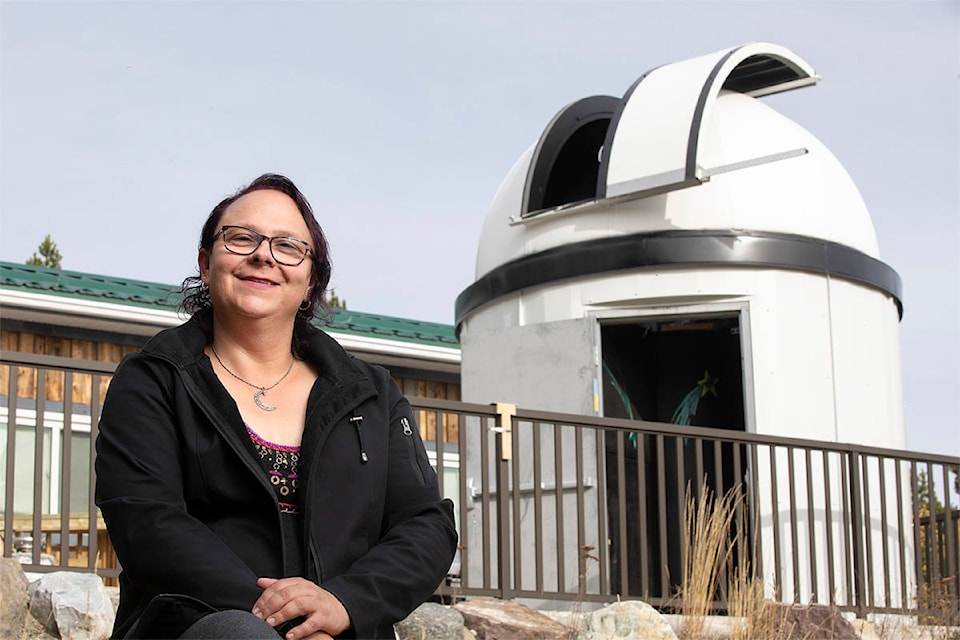As long as the stars align, local astronomy enthusiasts will gather — at a distance — Sept. 18 to take a closer view of the night sky from the observatory at Takhini Hot Springs.
The Royal Astronomical Society of Canada, Yukon Centre (also known as Yukon Astronomical Society) will host its first star gazing party of the season beginning at 9 p.m. and distancing measures will be in place.
The event is planned for the night of Sept. 18, but if the weather does not cooperate it will be moved to Sept. 19 and would also begin at 9 p.m.
Vikki Zsohar, president of the local organization, said the event will mark the reopening of the observatory since it was shut due to COVID-19 earlier this year. While the reopening will be limited to individual events like the star gazing party, Zsohar said she anticipates monthly observation nights and perhaps an extra event around the Christmas season as the group works to ensure its gatherings meet social distancing requirements.
| The observatory dome at the Yukon Astronomical Observatory and Interpretive Centre outside Whitehorse on Sep. 16, 2020. (Crystal Schick/Yukon News) |
Zsohar said based on previous events the society has held, she’s expecting around 20 and given the space available outside the observatory, there is plenty of room for everyone to keep distant while still observing the night sky together.
For the more experienced astronomers of the group, it will be a chance to get out and observe the night sky with others interested in seeing the planets while newer astronomers may get to experience the night sky in a new way, using one of the astronomical telescopes the society has available.
A number of astronomical society members already have their own telescopes, which allow viewers to take in more details of the celestial bodies they are observing, while the society has two larger telescopes and a number of smaller ones it can provide.
It’s a good opportunity for those interested in space to try out the telescopes and learn a little more about the night sky, Zsohar said.
“Jupiter will be up,” she commented, also noting Saturn and Mars are expected to be visible.
On timeanddate.com, a website that provides forecasts about weather, night skis and other natural phenonena around the world, it’s noted for Whitehorse that Jupiter and Mars are expected to have perfect visibility both Sept. 18 and 19 with good visibility anticipated for Saturn on those nights.
Jupiter is expected to rise close to 6:30 p.m. both nights with Saturn to follow after about 6:40 p.m. and Mars closer to 9 p.m. each night.
Uranus, meanwhile, is listed as having an expected average visibility beginning around 8:40 p.m. both nights, while Neptune is expected to be “slightly difficult to see”, rising around 8 p.m. The other two major planets in the solar system — Venus and Mercury — rise in the mornings with Venus having good visibilty beginning after 3 a.m. both Sept. 18 and 19 and Mercury anticipated to rise after 10:15 a.m. each day though it will be difficult to see.
With astronomical telescopes, observers can see details like Saturn’s rings, the larger moons of Jupiter and the craters of Mars, among others.
Taking that in for the first time is very exciting, Zsohar said.
“I hear lots of wows,” she recalled of watching people experience an astronomical telescope for the first time.
| The main telescope at the observatory dome at the Yukon Astronomical Observatory and Interpretive Centre outside Whitehorse on Sep. 16, 2020.(Crystal Schick/Yukon News) |
Many of those using a telescope for the first time have told her they didn’t realize they’d be able to see such detail in the cosmos prior to this.
While getting to use a telescope specifically designed to view the stars, planets and other features that light up the night sky is an excellent way to view the cosmos, Zsohar noted simply looking up at the sky can also reap rewards.
Early risers in the territory who have stepped out and looked up to see a small bright object in the sky that’s not the sun are seeing Venus.
“It’s beautiful,” Zsohar said.
It’s also a sign that the colder season is here.
As stated on the Royal Astronomic Society of Canada website: “Sure signs of winter knocking at the door in a few months is seeing the constellation Orion well up in the east and along with Venus, the Hyades and Pleiades (star clusters). This is something to witness on a clear moonless morning.”
Similarly, Jupiter can also be easily seen in the sky without the need of a telescope, though at night.
“These planets are so bright,” Zsohar said, adding that even with a basic pair of binoculars, Jupiter’s four largest moons — Io, Europa, Ganymede and Callisto — can be viewed on a clear night.
Contact Stephanie Waddell at stephanie.waddell@yukon-news.com
